Foul Imitation?

For the last few weeks, social media has been flooded with images that look like they belong in a Studio Ghibli film. People are using OpenAI’s latest ChatGPT update to turn their photos and memes into soft pastel, hand-drawn animations reminiscent of Hayao Miyazaki’s famous style. It started as a fun trend but has quickly become a topic of controversy as well. More accurately, the trend has raised some serious questions regarding copyright and artistic ownership — an allegation to which ChatGPT products are not strangers.
Visual forms of generative AI model, like the ChatGPT’s image creator under question, do not store original artwork. Instead, they learn patterns and styles from vast amounts of data and apply them to new images. Users don’t need to provide detailed descriptions — just mentioning ‘Studio Ghibli’ is enough for the AI to understand and create an image in that style. This is both exciting and concerning. While it seemingly allows anyone to experiment with forms of artistic expression, it also raises ethical issues about whether AI should be allowed to mimic such distinct copyrighted styles.
It may be recollected that copyright laws traditionally protect specific works, not general styles. This means that while an AI-generated image may look like a Studio Ghibli scene, it doesn’t directly copy any existing frame. That’s why some experts argue that OpenAI isn’t technically breaking any laws. But many artists feel the other way. If AI can easily generate work in their unique styles without permission, it will threaten the artist’s creative identity and livelihood. Certain news reports suggest that Polish artist Greg Rutkowski has seen his name used in AI prompts over 93,000 times, and some artists, including Karla Ortiz, are taking legal action against AI companies for using their work without consent. Studio Ghibli hasn’t officially responded to this latest trend, but Miyazaki’s views on AI are well known. He has previously called AI animation an “insult to life itself.” In a 2016 video, he reacted with disgust to an AI-generated demo, saying that creators of such technology had no understanding of human emotion or struggle. Given his strong stance, many fans feel that using AI to imitate his work goes against everything Ghibli stands for. Beyond the artistic concerns, the trend has taken unexpected turns. Governments and politicians have used Ghibli-style AI images for messaging, sometimes in controversial ways. This raises another issue—when AI-generated art is detached from its original intent, it can be used in ways that the original artists would never have approved of.
As AI technology continues to evolve, the debate around copyright and artistic ownership will only grow. Right now, there are no clear legal protections for distinctive artistic styles. But many believe new regulations will be needed to prevent AI from undermining human creativity. AI-generated art can be a powerful tool, given that it is used responsibly. The challenge ahead is finding a balance that allows plenty of room for technological innovation while still respecting and firmly protecting the artists who have spent their lives creating something truly unique. Art can metaphorically be dubbed as the soul of human existence in various clusters, and the creators of the same acquire a Godly stature that must be respected at all cost!



